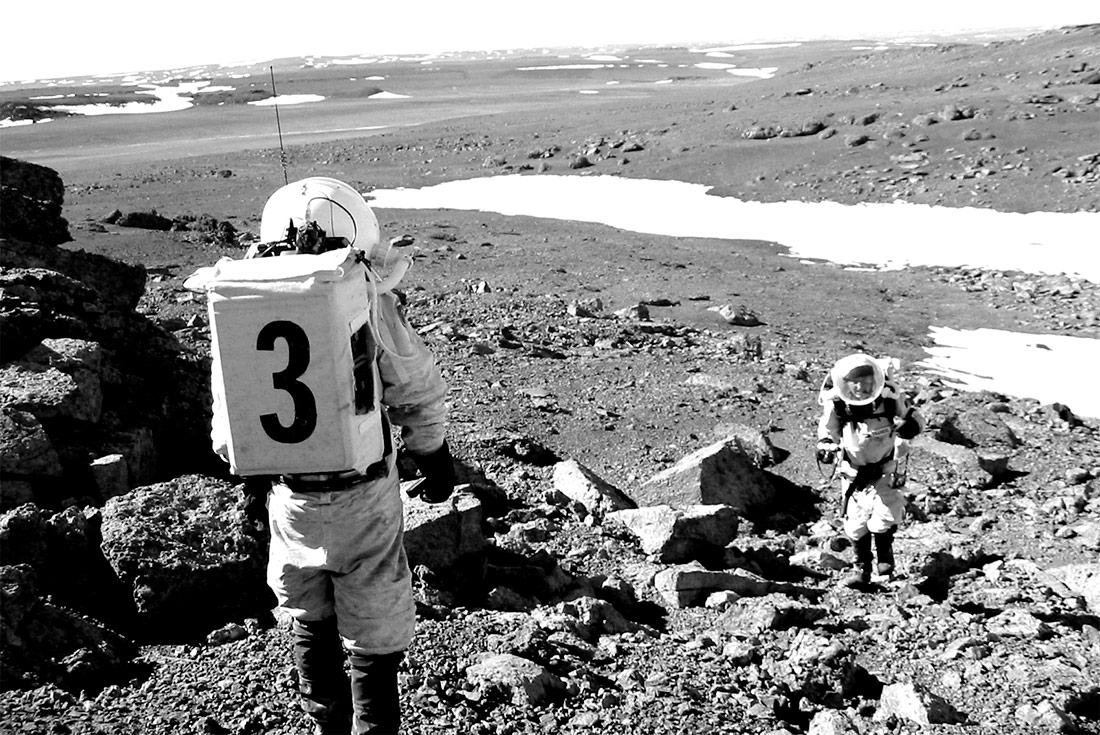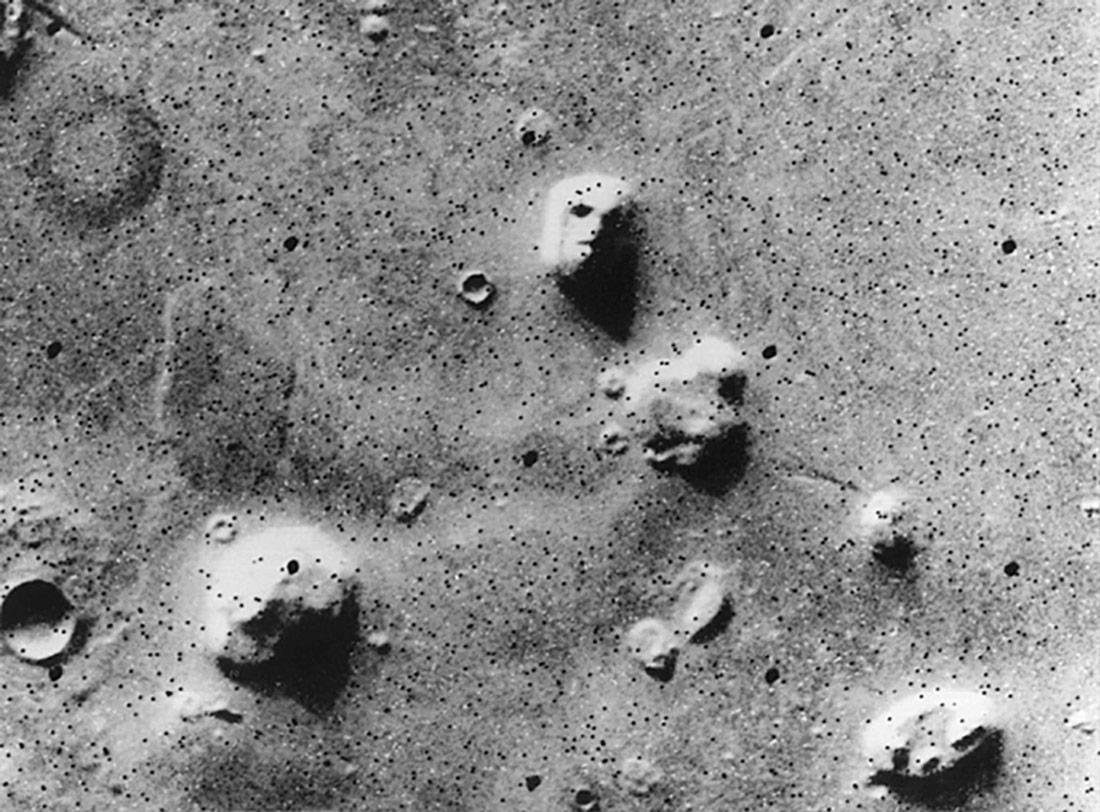
Crew 3 members climb Marine Rock on Devon Island, near the Flashline Mars Arctic Research Station. 2001 | The Mars Society, Wikimedia Commons | CC BY-SA
Our relationship with Mars has lived through a clear evolution since the end of the 19th century. As we have learned more about our planetary neighbour, its use in comics as a scenario for pulp adventurers has given way to narratives about the existential void to which society exposes us and, ultimately, its potential use as a new home in which to establish ourselves and enjoy a (well-deserved?) second chance. Cartoons filled with sci-fi but also with an important reflection on human nature. In the run-up to the exhibition “Mars. The Red Mirror” planned for the end of this year, we will be publishing a series of articles on the planet, because thinking about Mars, ultimately, means thinking about Earth.
In a little over a century, the planet Mars has gone from having “hic sunt dracones”engraved on its surface to standing as a possible tourist destination and a remote alternative for housing the remains of a race that is heading for extinction. Seemingly our relationship with the Red Planet has grown in confidence as we have learned more about its atmosphere and our terraforming capacity. The mysteries have gradually disappeared, or at least, they have been transformed into other earthlier ones. And our fictions have shown this over the course of the years.
Specifically, science-fiction narrative has been going Mars-mad since the end of the 19th century when there was a boom in speculation regarding the existence of life on our neighbouring planet. Probably the most paradigmatic example of this lies in the novel The War of the Worlds (1898) by H. G. Wells, but many other media have given accounts of that red dot in the sky. Like the comic strip, a format that was blooming into its modern phase and simultaneously breaking out into the mass press.
Pulp and Sunday comic strips
The colonial voracity and explorations of different kinds had confirmed an increasingly obvious reality: that there were few corners for humans left to explore on terra firma. Our world map was increasingly more precise, so we dared to map out other places, other worlds. And it was precisely during the drawing up of the increasingly refined Martian cartographies of the 19th century, that two observations were made (both incorrect, in fact), that would catapult our imagination into the atmosphere of this inhospitable planet. First of all, it was said that there was water on the surface of Mars. And secondly, that the planet had a network of artificial canals, which meant that somebody had built them, which meant that there was life on Mars.

Martian canals were first described by the Italian astronomer Giovanni Schiaparelli during the opposition of 1877, and confirmed by later observers. Giovanni Schiaparelli’s map of Mars | NASA | Public Domain
The weekly cartoon strips published in the newspapers were peopled with a broad assortment of adventurers who decided to travel to the Red Planet to find extra-terrestrial creatures and unfathomable mysteries. In the American comic strip Connie, a main character, inspired by the pulp heroines of the 1920s, was required by wise Venusians to explore the strange canals of Mars. There, she came up against telepathic beings, revolutionary murderers, fishmen, birdmen and monstrous creatures, but all this exoticism would still reflect conflicts that were quite everyday for the common earthling. Connie would thus follow the path initially forged by the likes of Buck Rogers and Flash Gordon (a Flash Gordon, by the way, whose original destination in one of his films would be changed to Mars in order to take advantage of the success of a radio programme that, in the late 1930s, would revolutionise the history of this medium: we are referring, of course, to the broadcasting of The War of the Worlds by Orson Welles.)
John Carter would be another of the great adventurers entrusted with putting foot on Mars – in this case, through astral projection – in order to dish out a very earthly type of justice. What started in the 1940s as an adaptation of the stories of one of the characters by Edgar Rice Burroughs ended up, with the passage of the years, becoming an intermittent presence in different series starring himself, or alternatively doing cameos in comics such as that of Tarzan in the 1950s.
In that same decade, different incursions emerged in the sequential art that changed the predominant tone of “human hero fixes Martian problems”. Issue number 9 of Weird Fantasy included, in 1951, the tale Spawn of Mars by Wallace Wood, one of the first stories to feature body snatchers, complete with interspecies pregnancy included. Issue number 255 of Detective Comics, which introduced us for the first time to Martian Manhunter, the first hero who followed the opposite path between the two planets. Our Martian detective was tall, green and bald, as well as telepathic, shape-shifting and (to mention at least one fault) very sensitive to fire. We cannot omit to mention the fluke of one Jack Kirby who, in 1958, described in The Face on Mars the discovery by a group of explorers of an artificial structure with the form of a face on the Martian surface. Yes, that same pareidolia that in the 1970s would drive an entire generation of conspiracists crazy with the discovery by NASA of a geographical accident that looked very similar.

The “Face on Mars” was one of the most striking and remarkable images taken during the Viking missions to the red planet | Viking 1, NASA | Public Domain
Existential void and interplanetary colonialism
As Mars was being explored from our telescopes and no Martian neighbour stuck his head out to say hello, the vision of that enigmatic Mars gradually gave way to an empty planet that, like a blank canvas, served us to portray the human psyche. And if Mars had to be a desertic and inhospitable terrain, then so be it, for our authors that was just fine. Just tell Alan Moore, who used those infinite wastelands for the spiritual retirement of Dr Manhattan in Watchmen. This was the superhero’s solution for banishing the incessant noise of a humanity continually in dispute and with the Cold War as backdrop. Another reflection of the anti-communist paranoia was Commies from Mars, although its focus was much closer to satire and the most irreverent humour. This collection, coordinated by Ted Boxwell, brought together many of the best underground artists of the era to create different short stories whose premise was always the same: the presence of communist invaders from Mars.
And then we took the first step onto the Martian surface, even though the foot – or wheel – we did so with was robotized. The promising technological advances that came with the 21st century and the increasingly close possibility of making a manned voyage to Mars were the catalyst for many sci-fi stories over recent decades. This was the starting point for works such as Aria, fantastic sci-fi manga from Kozue Amano which tells how we have managed to terraform Mars and convert it into a planet nearly completely covered by oceans whose main city is called Neo-Venice. Following the manga path we find Terra Formars, a story about a U-NASA expedition sent to the Red Planet that comes up against a race of giant cockroaches which have to be exterminated. But if the idea is to select a work that combines formal virtuosity and narrative mastery, then we are obliged to mention Chris Ware and The Seeing-Eye Dogs of Mars. This tale within a tale that forms part of the Acme Novelty Library #19 constructs an underlying domestic drama disguised as a Martian epic. A story with numerous and inexhaustible readings – like all of Ware’s stories – that converts the planet Mars into the perfect allegory of loneliness and isolation. Because that brilliant dot in the sky that we can barely distinguish from the other stars has never ceased to be that: a metaphor of a possible world. A symbol of otherness and, for that same reason, of our own nature. A mirror in which to gaze at ourselves and discover that, perhaps, we don’t like what we see. Let’s see who’s got the guts to look first.





Leave a comment